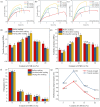A calcium sulfate hemihydrate self-setting interface reinforced polycaprolactone porous composite scaffold
- PMID: 40103987
- PMCID: PMC11917470
- DOI: 10.1039/d5ra00010f
A calcium sulfate hemihydrate self-setting interface reinforced polycaprolactone porous composite scaffold
Abstract
The mechanical insufficiency and slow degradation of polycaprolactone (PCL) implants have attracted widespread attention among researchers. Herein, a PCL scaffold with self-setting properties containing calcium sulfate hemihydrate (CSH) was prepared using a triply periodic minimal surfaces (TPMS) design and selective laser sintering (SLS) technology. The results showed that the strength of the scaffold containing 10 wt% CSH was increased by 45.5% compared to the PCL one. More importantly, its strength can be further increased to 1.7 times that of the PCL scaffold after self-setting in water. Mechanism analysis suggests that mechanical strengthening can be attributed to the pinning effect through the newly grown columnar crystals embedded with PCL molecular chains. In addition, the degradation rate of the composite scaffold was approximately 6.8 times higher than that of the PCL one. The study believes that the increase in degradation rate is due to a dual effect, specifically the increase in permeability and the catalytic degradation of PCL in the acidic environment. Encouragingly, the composite scaffold showed a good ability to induce hydroxyapatite formation. Therefore, the self-setting mechanically enhanced composite scaffold is expected to have potential application prospects in bone defect repair.
This journal is © The Royal Society of Chemistry.
Conflict of interest statement
The authors declare that they have no known competing financial interests or personal relationships that could have appeared to influence the work reported in this paper.
Figures











Similar articles
-
Mechanical Strengthening and Degradation Regulation of Iron Foam-Polycaprolactone Interpenetrating Composite Scaffolds.ACS Appl Bio Mater. 2025 May 19;8(5):4104-4118. doi: 10.1021/acsabm.5c00262. Epub 2025 Apr 20. ACS Appl Bio Mater. 2025. PMID: 40254859
-
Crosslinking of a polycaprolactone/tourmaline scaffold by sodium stearate with improved mechanical strength and bioactivity.RSC Adv. 2023 Aug 15;13(35):24519-24535. doi: 10.1039/d3ra04273a. eCollection 2023 Aug 11. RSC Adv. 2023. PMID: 37588979 Free PMC article.
-
Tetracalcium phosphate/polycaprolactone composite scaffold: Mechanical reinforcement, biodegradability regulation and bioactivity induction.J Mech Behav Biomed Mater. 2023 Nov;147:106144. doi: 10.1016/j.jmbbm.2023.106144. Epub 2023 Sep 21. J Mech Behav Biomed Mater. 2023. PMID: 37748317
-
Osteogenesis of adipose-derived stem cells on polycaprolactone-β-tricalcium phosphate scaffold fabricated via selective laser sintering and surface coating with collagen type I.J Tissue Eng Regen Med. 2016 Oct;10(10):E337-E353. doi: 10.1002/term.1811. Epub 2013 Aug 16. J Tissue Eng Regen Med. 2016. PMID: 23955935
-
Micromechanical finite-element modeling and experimental characterization of the compressive mechanical properties of polycaprolactone-hydroxyapatite composite scaffolds prepared by selective laser sintering for bone tissue engineering.Acta Biomater. 2012 Aug;8(8):3138-43. doi: 10.1016/j.actbio.2012.04.022. Epub 2012 Apr 19. Acta Biomater. 2012. PMID: 22522129 Free PMC article.
References
-
- Chen Y. Quan S. Huang S. Liu W. Chen Z. Liu J. Li C. Yang H. Ceram. Int. 2024;50:48891–48908.
-
- Sheng X. Che Z. Qiao H. Qiu C. Wu J. Li C. Tan C. Li J. Wang G. Liu W. Gao H. Li X. Int. J. Biol. Macromol. 2024;277:133806. - PubMed
-
- Kumar Parupelli S. Saudi S. Bhattarai N. Desai S. Int. J. Bioprint. 2023;9:0196.
LinkOut - more resources
Full Text Sources

